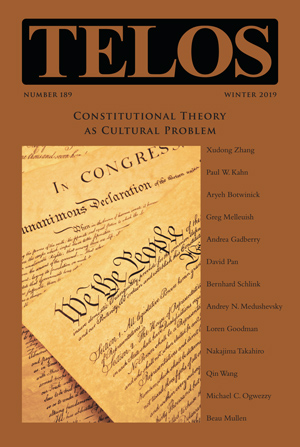In today’s episode of the Telos Press Podcast, Camelia Raghinaru talks with Loren Goodman about his article “Poetic Impositions: Japanese–U.S. Constitutional Problems of Peace and Tranquility,” from Telos 189 (Winter 2019). An excerpt of the article appears below. If your university has an online subscription to Telos, you can read the full article at the Telos Online website. For non-subscribers, learn how your university can begin a subscription to Telos at our library recommendation page. Purchase a print copy of Telos 189 in our online store.
Poetic Impositions: Japanese–U.S. Constitutional Problems of Peace and Tranquility
Loren Goodman
Introduction
 As Garrett Epps declares in his 2013 constitutional study “Poetry of the Preamble,” while the phrase “‘We the people of the United States’ is etched deep in the national consciousness,” the people were not involved in its composition. Epps argues that those who wrote it speak to the people in their own voice so effectively that they have come “to believe that they gave birth to the Constitution, that it issued from, rather than being all but imposed upon, ‘the people.'” One wonders to what extent this holds true for the Japanese people, whose “peace constitution,” composed in 1946 by MacArthur’s military staff during the U.S. occupation, employs the same “We the people” language in its preamble.
As Garrett Epps declares in his 2013 constitutional study “Poetry of the Preamble,” while the phrase “‘We the people of the United States’ is etched deep in the national consciousness,” the people were not involved in its composition. Epps argues that those who wrote it speak to the people in their own voice so effectively that they have come “to believe that they gave birth to the Constitution, that it issued from, rather than being all but imposed upon, ‘the people.'” One wonders to what extent this holds true for the Japanese people, whose “peace constitution,” composed in 1946 by MacArthur’s military staff during the U.S. occupation, employs the same “We the people” language in its preamble.
In examining the U.S. Constitution as a poetic text, Epps also applies Charles Olson’s definition of poetry as a field of “energy transferred from where the poet got it . . . by way of the poem itself . . . to the reader . . . a high-energy construct and, at all points, an energy-discharge.” The electrical metaphor recalls another useful definition of poetry—Ezra Pound’s—as “charged language” capable of transmitting shock.
It is difficult to imagine a shock of textual energy transfer greater than the one that occurred on February 13, 1946, when General Whitney, acting under MacArthur’s orders, informed Minister Matsumoto Joji that his constitutional draft revision, being insufficiently democratic, had been rejected in favor of a U.S. Government Section (GS) version, drafted over the course of one week by a team of twenty-four. A contemporaneous account reports that “the Japanese officials were obviously stunned—Mr. Yoshida’s face particularly manifesting shock and concern. The whole atmosphere at this point was charged with dramatic tension.”
Such shock was compounded by the ultimatum that this was his cabinet’s last chance to save the emperor and remain in power; if they did not accept the constitution by February 20, Whitney threatened to deliver it directly to the Japanese people. Adding ventriloquistic insult to injury, the Japanese not only had to accept this foreign constitution, they were required to “defend its legitimacy” by “maintaining the fiction that they had authored it themselves.”
Considering the history of the constitutionally commandeered voices of the Japanese people, I wish to explore their peace constitution as a poetic text with some attention to how it is read and what it means to the people who continue to live under it; to see how contemporary Japanese people, in their own voices, make sense of it.
Form and Function
In considering the formalist elements of poetry such as rhyme and meter as primarily mnemonic, pedagogical devices, one might also liken the temporal duress of the deadline to meter as a formal characteristic of texts based on time.
In this respect MacArthur’s time constraint had a monumental unintended effect in democratizing politics in Japan. Prior to the 1946 constitution, all legal documents were composed in bungotai (文語体), a classic Japanese literary style inaccessible to the majority of the people. Because the cabinet was unable to translate the GS draft into bungotai in the allotted time, they wrote it in colloquial Japanese. This set a new precedent: all government documents from then on were written in colloquial Japanese.
The thrice-repeated invocation, “We, the Japanese People,” in the 1946 preamble anaphorically infuses the piece with a song-like, prayer-like quality that goes beyond that of the 1789 template. But whose prayer? In some ways it feels like that of the American composers: a prayer that they would never again be confronted by such a formidable enemy.
Read sympathetically, the preamble, with its commitment to “preserve our security and existence” through “trusting in the faith of the peace-loving peoples of the world” is incredibly idealistic. Read critically, it is patronizing, vindictive, oppositional.
Continue reading this article at the Telos Online website (online subscription required). If your library does not yet subscribe to Telos, visit our library recommendation page to let them know how.



